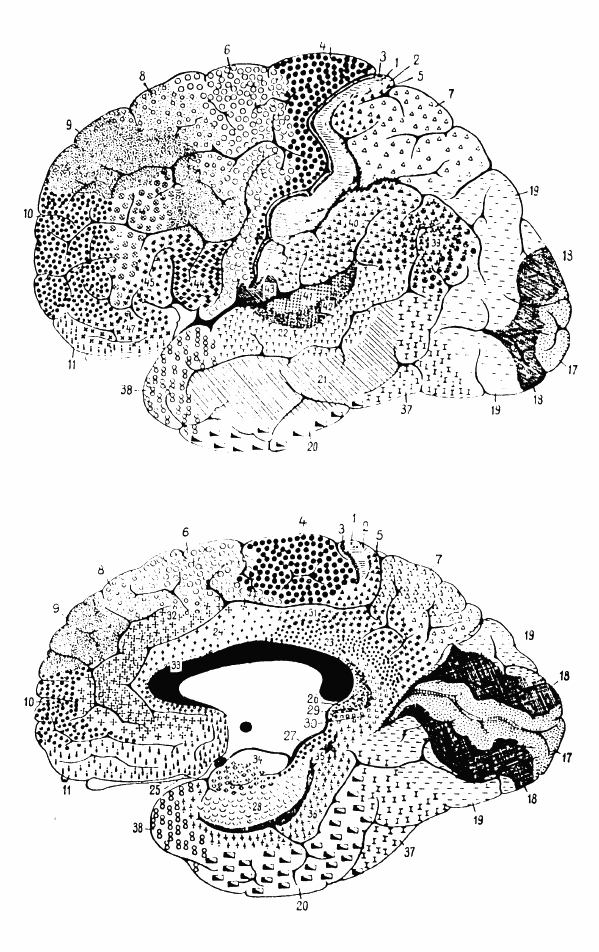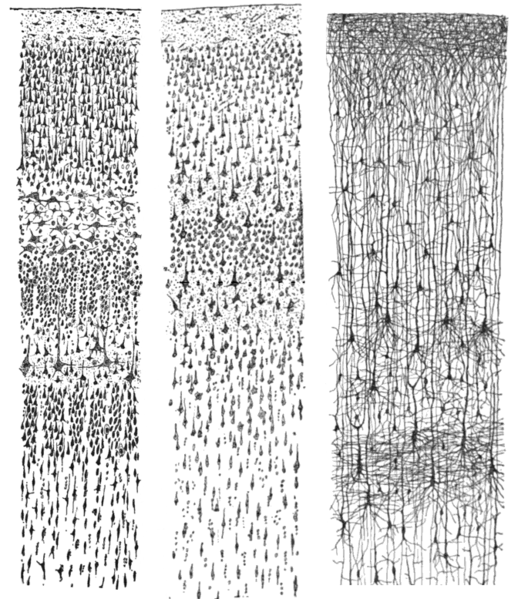Dr Korbinian Brodmann, German Neurologist, Frontpiece of ‘Localisation in the Cerebral Cortex’, 1909, Public Domain*
The Brain is a complex organ, responsible for the full gamete of our inner experiences whether these are our first thoughts on waking, the perception of a rainbow or the sharing of joy with others. Understanding the brain has been an almost unobtainable goal which many great scientists have striven for. One scientist who realised the immense complexity of the task set out to characterise the brain in a more limited way and in the process established one of the most successful maps of the brain which continues to be routinely used over 100 years later. His name was Dr Korbinian Brodmann. In the first part of this series, there was a brief look at the context of Brodmann’s landmark work ‘Brodmann’s Localisation in the Cerebral Cortex’. In the second part of the series we will take a closer look at the 21 pages of his book which relate to the special regions in the human Cerebral Cortex that Brodmann identified.
The central 21 pages of Brodmann’s work are contained within Chapter IV ‘Description of Individual Brain Maps’ in which he contrasts the brain maps of several species including humans. The first region he looks at is the Postcentral region.
Cytoarchitectonics of human brain according to Brodmann (1909), Public Domain*
According to Brodmann, the Postcentral Region is defined by the Central Sulcus. The Postcentral Region lies posterior to the Central Sulcus and is distinguished from the Precentral Region (lying anterior to the Central Sulcus) by the cytoarchitecture. Anteriorly the cytoarchitecture is characterised by large Pyramidal cells and an absent Inner Granular Layer, whilst the Postcentral Region is characterised by a lack of Giant Pyramidal Cells but the presence of a Granular Layer. The Central Sulcus is evident in the uppermost Brain in the diagram above where it demarcates the border between Brodmann Areas 4 and 3. With regards to this distinction it appears that he is referring to the Inner Granular Layer as he mentions its absence in the description of the Precentral Region although not explicitly in the Precentral Region. According to Brodmann’s description in the same book, layer IV would be the fourth layer in the Cerebral Cortex on moving from the Pial surface to the White Matter connections (to the Thalamus).
Three drawings by Santiago Ramon y Cajal, taken from the book “Comparative study of the sensory areas of the human cortex”, pages 314, 361, and 363, Public Domain*
Left: Nissl-stained visual cortex Middle: Nissl-stained motor cortex Right: Golgi-stained cortex
Brodmann goes on to describe 4 Postcentral areas
1. Brodmann Area 3
2. Brodmann Area 1
3. Brodmann Area 2
4. Brodmann Area 43
Turning firstly to Brodmann Area 3, although it was clear that this was defined by the above cytoarchitectural distinctions from the Precentral Region and its close relationship with the Central Sulcus, I wasn’t clear from Brodmann’s description of how Brodmann Area 3 was distinguished from Brodmann Area 2. Interestingly he goes on to comment that another Neuroanatomist Campbell distinguishes only two Postcentral regions. From the diagram above from Brodmann’s 1909 work, it is clear that BA3 lies mainly on the convexity of the lateral Cortical Surface although continuing onto the medial surface to a lesser extent. Along the sulcal borders there is some overlap between the Pre and Postcentral architecture with Brodmann describing a mixed architecture occurring in parts. Brodmann refers to BA3 as the Rostral Postcentral Area.
Turning now to Brodmann Area 2 (BA2), Brodmann refers to this as the Caudal Postcentral Area and describes it in relation to the Posterior aspect of the Postcentral Gyrus. In parts, Brodmann describes the difficulty in distinguishing it from BA1 particularly in the region around the Intraparietal Sulcus. Again although the course of BA2 is described , the uniquely characterising cytoarchitectural features are not identified by Brodmann within the Postcentral Region section.
Regarding Brodmann Area 1 (BA1) – the Intermediate Postcentral Area, Brodmann again describes the anatomical course of this region bordered by BA2 and BA3. Cytoarchitectural differences are hinted at by reference to the lower part of the Postcentral Gyrus where the borders with BA2 and BA3 result in a mixed cytoarchitecture.
Finally there is Brodmann Area 43 (BA43) – the Subcentral Area. This is described as a region which results from the unification of the Pre and Postcentral Gyri inferior to the Central Sulcus. Brodman describes BA43 as passing into the ‘depths’ of the Sylvian fissure and bordering with the Insular Cortex.
These areas in the Postcentral region are known to be the Somatosensory Cortex, the location of the well known Sensory Homunculus.
References
Brodmann’s Localisation in the Cerebral Cortex. 1909. Translated and Edited by Laurence J Garey. Springer. 2006.
*Public Domain in those countries where the Copyright term of the life of the author (Korbinian Brodmann 1868-1918) plus the additional country specific term has lapsed from Copyright at the time of writing
An index of the TAWOP site can be found here and here. The page contains links to all of the articles in the blog in chronological order. Twitter: You can follow ‘The Amazing World of Psychiatry’ Twitter by clicking on this link. Podcast: You can listen to this post on Odiogo by clicking on this link (there may be a small delay between publishing of the blog article and the availability of the podcast). It is available for a limited period. TAWOP Channel: You can follow the TAWOP Channel on YouTube by clicking on this link. Responses: If you have any comments, you can leave them below or alternatively e-mail justinmarley17@yahoo.co.uk. Disclaimer: The comments made here represent the opinions of the author and do not represent the profession or any body/organisation. The comments made here are not meant as a source of medical advice and those seeking medical advice are advised to consult with their own doctor. The author is not responsible for the contents of any external sites that are linked to in this blog.



[…] News Round-Up: February 2012 4th EditionWhatever Happened to Brodmann Area 27“The Brodmann areas” a new balletAres Gear Ranger Belt – A Brief Review – The Shooters Blog The Shooters BlogThe Most Important 21 Pages In The Field of Neuroscience […]
LikeLike
[…] The Most Important 21 Pages In The Field of Neuroscience? Dr Korbinian Brodmann. The Man Who Mapped … […]
LikeLike
Good Morning, I just stopped by to visit your blog and thought I’d say thank you.
LikeLike
[…] The Most Important 21 Pages In The Field of Neuroscience? Dr Korbinian Brodmann. The Man Who Mapped … […]
LikeLike
[…] The Most Important 21 Pages In The Field of Neuroscience? Dr Korbinian Brodmann. The Man Who Mapped … […]
LikeLike
[…] The Most Important 21 Pages In The Field of Neuroscience? Dr Korbinian Brodmann. The Man Who Mapped … […]
LikeLike
[…] The Most Important 21 Pages In The Field of Neuroscience? Dr Korbinian Brodmann. The Man Who Mapped … […]
LikeLike
[…] The Most Important 21 Pages in the Field of Neuroscience: Dr. Korbinian Brodmann – Part 2 R… […]
LikeLike
[…] The Most Important 21 Pages In The Field of Neuroscience? Dr Korbinian Brodmann. The Man Who Mapped … […]
LikeLike